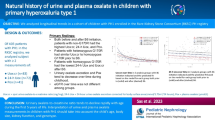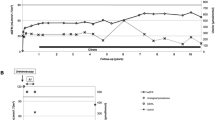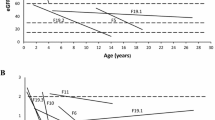Abstract
Background
Although hyperuricemia is a widely studied condition with well-known effects on the kidneys, hypouricemia is usually considered a biochemical abnormality of no clinical significance despite the fact that it can be a sign or major finding of serious metabolic or genetic diseases affecting kidney health. In this study, we aimed to investigate and emphasize the clinical significance of hypouricemia.
Methods
Patients were evaluated retrospectively for persistent hypouricemia defined as serum uric acid concentrations of < 2 mg/dL on at least 3 different occasions. According to the blood and urine uric acid (UA) levels, the patients were classified as having hypouricemia due to UA underproduction vs. overexcretion. Demographic, clinical, and genetic characteristics were noted for analysis.
Results
Fourteen patients (n = 14; M/F 8/6) with persistent hypouricemia were identified. Hypouricemia due to underproduction was the cause of 42.8% of these cases. All of the patients with a uric acid level of 0 mg/dL (n = 4) had hypouricemia due to underproduction. The median serum uric acid level was 0.85 (0–1.6) mg/dL. Isolated hypouricemia and hypouricemia with metabolic acidosis were equally distributed. Among the patients with hypouricemia due to underproduction, the final diagnoses were xanthine dehydrogenase deficiency (n = 5) and alkaptonuria (n = 1). In the overexcretion group, the final diagnoses were nephropathic cystinosis (n = 6), distal renal tubular acidosis (n = 1), and hereditary renal hypouricemia (n = 1). The diagnostic lag was longer for patients with isolated hypouricemia compared to other patients (p = 0.001).
Conclusions
Hypouricemia may reflect underlying genetic or metabolic diseases, early diagnosis of which could help preserve kidney function.
Graphical abstract

A higher resolution version of the Graphical abstract is available as Supplementary information
Similar content being viewed by others
Data availability
The datasets generated during and/or analysed during the current study are not publicly available but are available from the corresponding author on reasonable request.
References
Dissanayake LV, Spires DR, Palygin O, Staruschenko A (2020) Effects of uric acid dysregulation on the kidney. Am J Physiol Renal Physiol 318:F1252-f1257
Fathallah-Shaykh SA, Cramer MT (2014) Uric acid and the kidney. Pediatr Nephrol 29:999–1008
Jung SW, Kim SM, Kim YG, Lee SH, Moon JY (2020) Uric acid and inflammation in kidney disease. Am J Physiol Renal Physiol 318:F1327–F1340
So A, Thorens B (2010) Uric acid transport and disease. J Clin Invest 120:1791–1799
Kielstein JT, Pontremoli R, Burnier M (2020) Management of hyperuricemia in patients with chronic kidney disease: a focus on renal protection. Curr Hypertens Rep 22:102
Mallat SG, Al Kattar S, Tanios BY, Jurjus A (2016) Hyperuricemia, hypertension, and chronic kidney disease: an emerging association. Curr Hypertens Rep 18:74
Ramirez-Sandoval JC, Madero M (2018) Treatment of hyperuricemia in chronic kidney disease. Contrib Nephrol 192:135–146
Aoki Y, Sofue T, Kawakami R, Ozaki T, Manabe M, Kanda K, Yoda T, Kusaka T, Hirao T, Minamino T (2022) Prevalence and factors related to hypouricemia and hyperuricemia in schoolchildren: results of a large-scale cross-sectional population-based study conducted in Japan. Sci Rep 12:17848
Neyzi O, Bundak R, Gökçay G, Günöz H, Furman A, Darendeliler F, Baş F (2015) Reference values for weight, height, head circumference, and body mass ındex in Turkish children. J Clin Res Pediatr Endocrinol 7:280–293
Baldree LA, Stapleton FB (1990) Uric acid metabolism in children. Pediatr Clin North Am 37:391–418
Ramsdell CM, Kelley WN (1974) The clinical significance of hypouricemia. Adv Exp Med Biol 41:709–716
Sebesta I, Stiburkova B, Bartl J, Ichida K, Hosoyamada M, Taylor J, Marinaki A (2011) Diagnostic tests for primary renal hypouricemia. Nucleosides Nucleotides Nucleic Acids 30:1112–1116
Matos V, Van Melle G, Werner D, Bardy D, Guignard JP (1999) Urinary oxalate and urate to creatinine ratios in a healthy pediatric population. Am J Kidney Dis 34:e1
Poyrazoğlu HM, Düşünsel R, Yazici C, Durmaz H, Dursun I, Sahin H, Gündüz Z, Gürgöze MK (2009) Urinary uric acid : creatinine ratios in healthy Turkish children. Pediatr Int 51:526–529
Schwartz GJ, Brion LP, Spitzer A (1987) The use of plasma creatinine concentration for estimating glomerular filtration rate in infants, children, and adolescents. Pediatr Clin North Am 34:571–590
Schwartz GJ, Haycock GB, Edelmann CM Jr, Spitzer A (1976) A simple estimate of glomerular filtration rate in children derived from body length and plasma creatinine. Pediatrics 58:259–263
Johnson RJ, Bakris GL, Borghi C, Chonchol MB, Feldman D, Lanaspa MA, Merriman TR, Moe OW, Mount DB, Sanchez Lozada LG, Stahl E, Weiner DE, Chertow GM (2018) Hyperuricemia, acute and chronic kidney disease, hypertension, and cardiovascular disease: report of a scientific workshop organized by the National Kidney Foundation. Am J Kidney Dis 71:851–865
Park JH, Jo YI, Lee JH (2020) Renal effects of uric acid: hyperuricemia and hypouricemia. Korean J Intern Med 35:1291–1304
Wakasugi M, Kazama JJ, Narita I, Konta T, Fujimoto S, Iseki K, Moriyama T, Yamagata K, Tsuruya K, Asahi K, Kimura K, Kondo M, Kurahashi I, Ohashi Y, Watanabe T (2015) Association between hypouricemia and reduced kidney function: a cross-sectional population-based study in Japan. Am J Nephrol 41:138–146
Kuwabara M, Niwa K, Ohtahara A, Hamada T, Miyazaki S, Mizuta E, Ogino K, Hisatome I (2017) Prevalence and complications of hypouricemia in a general population: a large-scale cross-sectional study in Japan. PLoS One 12:e0176055
Maiuolo J, Oppedisano F, Gratteri S, Muscoli C, Mollace V (2016) Regulation of uric acid metabolism and excretion. Int J Cardiol 213:8–14
Furuhashi M (2020) New insights into purine metabolism in metabolic diseases: role of xanthine oxidoreductase activity. Am J Physiol Endocrinol Metab 319:E827–E834
Nakayama A, Matsuo H, Ohtahara A, Ogino K, Hakoda M, Hamada T, Hosoyamada M, Yamaguchi S, Hisatome I, Ichida K, Shinomiya N (2019) Clinical practice guideline for renal hypouricemia (1st edition). Hum Cell 32:83–87
Pineda C, Soto-Fajardo C, Mendoza J, Gutiérrez J, Sandoval H (2020) Hypouricemia: what the practicing rheumatologist should know about this condition. Clin Rheumatol 39:135–147
Meisel AD, Diamond HS (1977) Hyperuricosuria in the Fanconi syndrome. Am J Med Sci 273:109–115
Besouw MTP, Bienias M, Walsh P, Kleta R, Van’t Hoff WG, Ashton E, Jenkins L, Bockenhauer D (2017) Clinical and molecular aspects of distal renal tubular acidosis in children. Pediatr Nephrol 32:987–996
Köksoy AY (2021) Acute kidney injury, metabolic acidosis, and hypercalcemia with proximal tubular dysfunction—a diagnostic challenge: Answers. Pediatr Nephrol 36:2705–2707
Edvardsson V (2016) Urolithiasis in children. In: Avner ED (ed) Pediatric Nephrology. Springer-Verlag, Berlin Heidelberg, pp 1821–1858
Sperling O (2006) Hereditary renal hypouricemia. Mol Genet Metab 89:14–18
Stiburkova B, Taylor J, Marinaki AM, Sebesta I (2012) Acute kidney injury in two children caused by renal hypouricaemia type 2. Pediatr Nephrol 27:1411–1415
Sebesta I, Stiburkova B, Krijt J (2018) Hereditary xanthinuria is not so rare disorder of purine metabolism. Nucleosides Nucleotides Nucleic Acids 37:324–328
Markert ML (1991) Purine nucleoside phosphorylase deficiency. Immunodefic Rev 3:45–81
Mittal R, Patel K, Mittal J, Chan B, Yan D, Grati M, Liu XZ (2015) Association of PRPS1 mutations with disease phenotypes. Dis Markers 2015:127013
Moriwaki Y, Yamamoto T, Nasako Y, Ohata H, Takahashi S, Tsutsumi Z, Yamakita J, Higashino K (1999) ‘Pseudohypouricosuria’ in alcaptonuria: homogentisic acid interference in the measurement of urinary uric acid with the uricase-peroxidase reaction. Ann Clin Biochem 36(Pt 4):501–503
Villegas R, Xiang YB, Elasy T, Xu WH, Cai H, Cai Q, Linton MF, Fazio S, Zheng W, Shu XO (2012) Purine-rich foods, protein intake, and the prevalence of hyperuricemia: the Shanghai Men’s Health Study. Nutr Metab Cardiovasc Dis 22:409–416
Kidney Disease Improving Global Outcomes (2013) KDIGO 2012 clinical practice guideline for the evaluation and management of chronic kidney disease. Kidney Int Suppl 3:1–150
Author information
Authors and Affiliations
Contributions
All authors read and approved the final manuscript.
Corresponding author
Ethics declarations
Informed consent
Informed consent was obtained from all individual participants included in the study or their families.
Conflict of interest
The authors declare no competing interests.
Additional information
Publisher's note
Springer Nature remains neutral with regard to jurisdictional claims in published maps and institutional affiliations.
Supplementary Information
Below is the link to the electronic supplementary material.
Rights and permissions
Springer Nature or its licensor (e.g. a society or other partner) holds exclusive rights to this article under a publishing agreement with the author(s) or other rightsholder(s); author self-archiving of the accepted manuscript version of this article is solely governed by the terms of such publishing agreement and applicable law.
About this article
Cite this article
Köksoy, A.Y., Görükmez, Ö. & Dorum, S. Clinical significance of hypouricemia in children and adolescents. Pediatr Nephrol 38, 3017–3025 (2023). https://doi.org/10.1007/s00467-023-05948-4
Received:
Revised:
Accepted:
Published:
Issue Date:
DOI: https://doi.org/10.1007/s00467-023-05948-4




